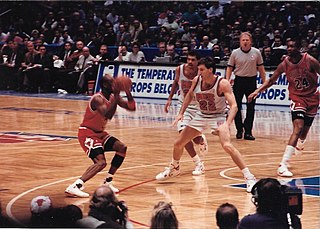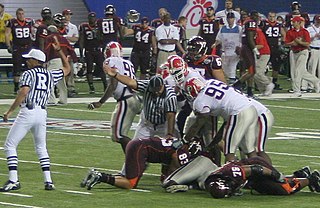
Basketball is a team sport in which two teams, most commonly of five players each, opposing one another on a rectangular court, compete with the primary objective of shooting a basketball through the defender's hoop, while preventing the opposing team from shooting through their own hoop. A field goal is worth two points, unless made from behind the three-point line, when it is worth three. After a foul, timed play stops and the player fouled or designated to shoot a technical foul is given one, two or three one-point free throws. The team with the most points at the end of the game wins, but if regulation play expires with the score tied, an additional period of play (overtime) is mandated.

In sports analytics, sabermetrics is the empirical analysis of baseball, especially baseball statistics that measure in-game activity. Sabermetricians collect and summarize the relevant data from this in-game activity to answer specific questions. The term is derived from the acronym SABR, which stands for the Society for American Baseball Research, founded in 1971. The term "sabermetrics" was coined by Bill James, who is one of its pioneers and is often considered its most prominent advocate and public face.

In many team sports that involve scoring goals, the goalkeeper is a designated player charged with directly preventing the opposing team from scoring by blocking or intercepting opposing shots on goal. Such positions exist in bandy, rink bandy, camogie, association football, Gaelic football, international rules football, floorball, handball, hurling, field hockey, ice hockey, roller hockey, lacrosse, ringette, rinkball, water polo, and shinty, as well as in other sports.

The point guard (PG), also called the one or the point, is one of the five positions in a regulation basketball game. A point guard has perhaps the most specialized role of any position. Point guards are expected to run the team's offense by controlling the ball and making sure that it gets to the right player at the right time. Above all, the point guard must understand and accept their coach's game plan; in this way, the position can be compared to the position of quarterback in Gridiron football. They must also be able to adapt to what the defense is allowing and must control the pace of the game.

The shooting guard (SG), also known as the two, two guard or off guard, is one of the five traditional positions in a regulation basketball game. A shooting guard's main objective is to score points for their team and steal the ball on defense. Some teams ask their shooting guards to bring up the ball as well; these players are known colloquially as combo guards. A player who can switch between playing shooting guard and small forward is known as a swingman. In the NBA, shooting guards usually range from 6 ft 4 in (1.93 m) to 6 ft 6 in (1.98 m) while in the WNBA, shooting guards tend to be between 5 ft 10 in (1.78 m) and 6 ft 1 in (1.85 m).

A box score is a structured summary of the results from a sport competition. The box score lists the game score as well as individual and team achievements in the game.
This is a glossary of terms in curling.

In basketball, there are five players on court per team, each assigned to positions. Historically, these players have been assigned to positions defined by the role they play on the court, from a strategic point of view. The three main positions are guard, forward, and center, with the standard team featuring two guards, two forwards, and a center. Over time, as more specialized roles developed, each of the guards and forwards came to be differentiated, and today each of the five positions is known by a unique name and number: point guard (PG) or 1, the shooting guard (SG) or 2, the small forward (SF) or 3, the power forward (PF) or 4, and the center (C) or 5.
Basketball moves are generally individual actions used by players in basketball to pass by defenders to gain access to the basket or to get a clean pass to a teammate to score.

In Australian rules football, a ruck, or ruckman/ruckwoman, is typically a tall and athletic player who contests at centre bounces and stoppages. The ruck is one of the most important players on the field. They are often key to coaching strategy and winning centre clearances which result in the most goal kicking opportunities.

This glossary of basketball terms is a list of definitions of terms used in the game of basketball. Like any other major sport, basketball features its own extensive vocabulary of unique words and phrases used by players, coaches, sports journalists, commentators, and fans.

In basketball, a double team is a defensive alignment in which two defensive players are assigned to catch the nut of a single offensive player.
Statistics in basketball are kept to evaluate a player's or a team's performance.
In sporting terminology, to telegraph is to unintentionally alert an opponent to one's immediate situation or intentions. The sporting use of the term telegraph draws a direct comparison with the communication device of the same name. "Telegraphing" always refers to a reflexive physical action rather than a protracted or intentional give-away. For example, a boxer rotating his shoulders to throw a hook would be telegraphing. A rugby team betraying its line-out plays by using an easily decoded line-out code is not telegraphing.
The game of lacrosse is played using a combination of offensive and defensive strategies. Offensively, the objective of the game is to score by shooting the ball into an opponent's goal, using the lacrosse stick to catch, carry, and pass the ball. Defensively, the objective is to keep the opposing team from scoring and to dispossess them of the ball through the use of stick checking and body contact or positioning.

This list is an alphabetical glossary of Australian rules football terms, jargon and slang. While some of these entries are shared with other sports, Australian rules football has developed a unique and rich terminology.

The 1–3–1 defense and offense is a popular strategy used in basketball.

A combo guard is a basketball player who combines the attributes of a point guard (1) and shooting guard (2), but does not necessarily fit the standard description of either position. In men's basketball, such guards are usually within the 6' 3" and 6' 5" height range. Most combo guards tend to be between point and shooting guards in terms of height, although some possess the height of a point or shooting guard specifically which affects how each plays.
Basketball is a ball game and team sport in which two teams of five players try to score points by throwing or "shooting" a ball through the top of a basketball hoop while following a set of rules. Since being developed by James Naismith as a non-contact game that almost anyone can play, basketball has undergone many different rule variations, eventually evolving into the NBA-style game known today. Basketball is one of the most popular and widely viewed sports in the world.

In sports, possession is physical control of the ball or other implement of play by one team, which typically gives that team the opportunity to score. Sports have different rules governing how possession is kept or lost, which affect the strategy of gameplay. The number of possessions or total time of possession are often useful statistics of team or individual performance.














